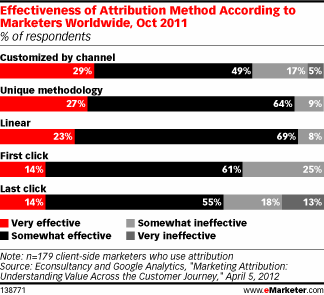Digital Attribution: one of the coming subject I’ll be working on. Super exciting 😉 Knowing that Google Analytics just started a serie of webinar on the subject… lucky me.
Appealing subject as posted before:
(Sorry, this one is in French)
I’ll not post anything for now about this, as I am discovering and don’t have any case study to share yet. However here are some quotes from this video which sum up the results of a must-read survey conducted by GA & eConsultancy, that I found relevant:
Why using Digital Attribution? “The primary goal is to justify digital spending – ~60%”
What’s the benefit of using Digital Attribution? “Better ability to allocate budget, ROI improvement & Better understanding of how channels work together”
What kind of method do you use? “Between first channel, last channel, linear, customize by channel… Customize by channel get the highest score of effectiveness.”
They are still companies using Excel [..] it’s hard and there is limitations… hum, hum… no kidding, I guess we all are!
Attribution is a complex world, there is a lot of factors to take in account, you can first think on what’s going on inside your online world […] e.g time for conversion, time between touches, type of interaction, touch point… […] and then you can think of all the things going on outside your online world […] e.g TVC Campaign, pricing modification, seasonality, brand level of awareness, competitors…
Last channel/click attribution model is flawed & missed signs of customer behaviour but is simple.
On specific part of this webinar was calling: How to form prior hypothesis about upper funnel behavior? To anticipate the models you could look at.
“Apply multiple models to compare assumption”
Models being:
1. Last click: 100% value to the last channel (used by 54% of marketers)
2. First click: 100% value to the first channel
3. Linear: value evenly shared to every channel
4. Time decay: value assigned by how close-in-time the channel is to the last conversion point
5. Position based :considering that 1st and last touch are more valuable than middle ones.
(Here is a great tool to built your own graph from Luna Metrics)
Regarding Google Analytics, it’s good to know that depending on the product you are using you will not have access to the complete range of models. When using the Google Analytics classic, you will have access to the multi-channel funnel feature & as Google Analytics Premium user you will access to the attribution modelling feature (which look powerful & super customizable). + When using Google Adwords, you have access to the search funnel tool (e.g very interesting to see how generic & branded KWD interact together on the conversion).
Well, that’s it for now but I should be back on this subject very soon I hope.



